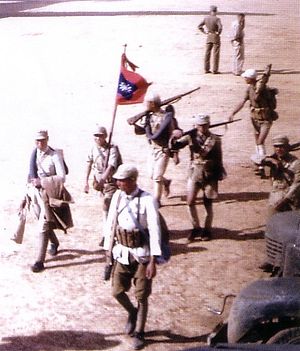In the middle of 1950, soon after the end of the Chinese Civil War, the remnant forces of the Kuomintang’s 8th Army, 26th Division, and 93rd Division crossed into the Shan State. After a tense period of formal and informal negotiations from the local level to the United Nations, information about the army was distributed to the public on a massive scale. A slew of documentary evidence compiled by the Burmese Ministry of Information emerged in 1953, supported by extensive reports in The Nation and Myawaddy. The language of “incursion” began to develop and be accepted as truth by both the metropolitan Myanmar audience and the watchful eyes of those further afield.
The literary works of a bespectacled Chinese professor, Professor Ting Tso-Shao, alias Hu Jing-rong, offer a different account. As a key advisor and representative for the remnant forces in Myanmar, Ting’s travel notes from the time reveal an intimate relationship with local elites and a keen curiosity for ethnic nuances in the region. Tied in with the entangled history between China and Myanmar, the notion of a KMT “incursion” becomes problematic, for it wholly ignores crucial lateral slices of history and politics in the KMT’s adopted borderlands location.
The first of these slices is the cyclical integration of Chinese exiles into northeastern Myanmar following upheaval and dynastic change in China. The flight of the Ming loyalists arises as the most salient example. The ethnic Chinese population in the Kokang region are largely descendants from this particular migration wave. Intriguingly, it was with the Kokang armed factions that the KMT remnant forces established their first local alliance in Myanmar. Is there really any difference between the “flight of the Ming loyalists” and the “incursion of Kuomintang aggressors”? Both groups fell on the “defeated” side of history as new, victorious dynasties emerged and embarked upon striking consolidations of power. Both group took to the hills and sought to carve out a new existence in the highland region east of the Salween river. Yet one group has been written into history as political refugees, and the other, as invaders.
This connection was fortified by a longrunning history of contact between itinerant Chinese traders and Shan local elites. The contours of the hills linking China to Myanmar had been traversed for generations by the Yunnanese caravan network. Some even argue that the KMT remnants themselves, many of whom were recruits from Yunnan, were descended from the caravan traders. The connection the trade fostered between traders and hillside elites was deep. Colonial reports remark that some traders enjoyed such a strong relationship with the local prince that they stayed in the palace during their visit to Kengtung.
Professor Ting was eager to remark upon the impression created by Chinese traders in Shan town centers: “Mengba, Mengyong, Tachilek, Kengtung, these can be divided into two parts: entirely Shan, and entirely Chinese.” Not only did the trade routes encourage Chinese merchants to incorporate into the society by migrating to various Shan towns, but local elites occasionally adopted Chinese dress and language, in part, to position themselves as brokers for the lucrative trade. Furthermore, intermarriage between Shan and Chinese created a distinct ethnic group of Chinese Shans. This cultural blending over successive generations raises questions about the semantic validity of an “incursion” conducted by Chinese individuals in the Shan State context.
Lastly, the concurrent waning of two ideological and political systems cannot be overlooked. Too frequently, studies of the KMT’s Southeast Asian project fall into Cold War systems of thinking about proxy wars and regional strategies. Too stringent a focus on these aspects neglects the concern of imminent political change that was no doubt at the forefront of the KMT’s and the Shan elites’ minds. In the early years of the “incursion” in 1950-3, Shan elites were already witnessing the disintegration of the feudal administrative system, a system that had more or less survived throughout the high colonial period. While the KMT remnants marched resolutely on in their cause of anti-Communism, they nonetheless could glean a sense of the new waves of political ideology brimming throughout Asia.
Ting remarked on the feudalism in the Shan states, “this remote region is brimming with the feudal mentality. In every town, there is a headman (‘a touren, ordinarily called laoba’)… much like our village heads (‘cunzhang’).” Ting hints at a mutual understanding between the KMT remnants and Shan elites of each other’s cause. In conversation with the Kengtung prince, Ting reports “he was aware of our anti-Communist principles; we thanked him for taking care of us… He said to us, ‘in the not too distant future, perhaps in two to three months, the world will experience epic change.’”
Ting had sympathy for the waning power of the Kengtung prince: “Burmese officials are sent to Kengtung one after another, particularly the military. The Kengtung prince watches this all unfold, as his power increasingly fades.” Later, Ting adds, “As Myanmar now so suddenly rides over his head, he is extremely unhappy… he hopes that China can come to his aid.”
From a vantage point in the old capital, Rangoon, much of the incursion narrative made sense. Yet by taking a closer look at the entangled histories between borderlands peoples, and the particular juncture in history they faced, the idea of something closer to a shared mission between Shan elites and Kuomintang cannot be discarded.
Alice Dawkins is a research student at the Australian National University and has studied Mandarin Chinese at Peking University. She also reads Burmese.

































